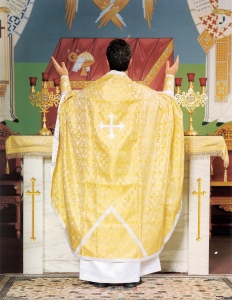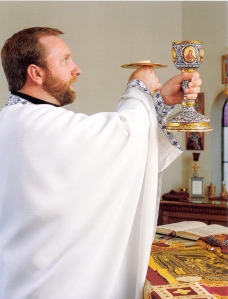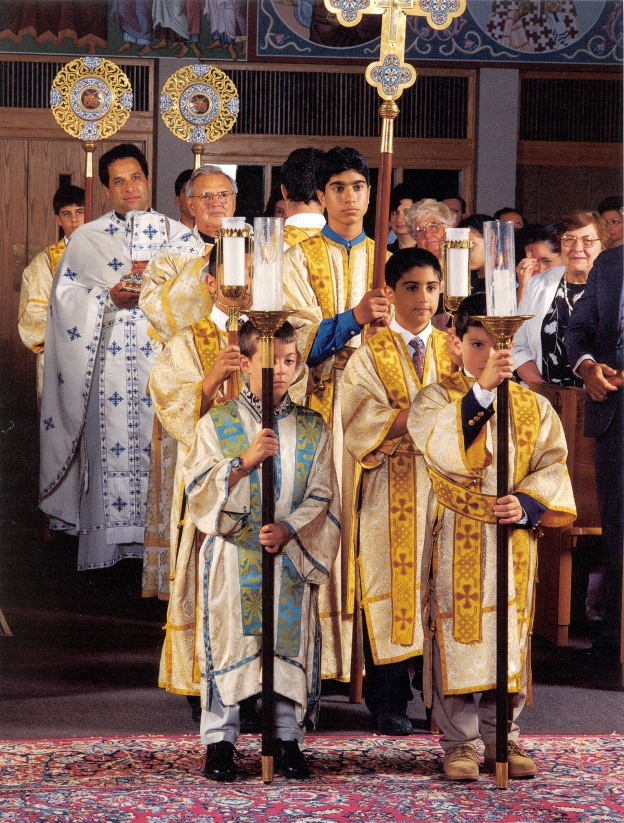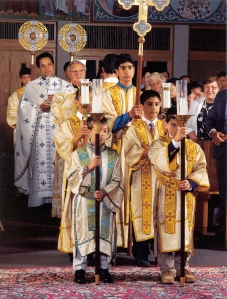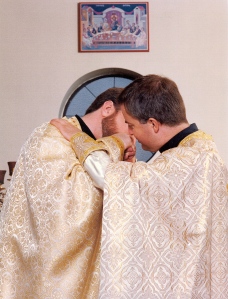This is the seventh in a series of blogs on the Divine Liturgy. The intent of the series is to remind us of what our children are learning about the service. That way we as a family can better understand what is happening around us during the Liturgy, and together we can more fully enter into “the offering of the people for the whole world!” (Photos courtesy of Teaching Pics: http://www.antiochian.org/christianeducation/teachingpics.)
We continue our look at the Liturgy of the Faithful by picking up where we left off: at the Lord’s Prayer. In this blog, we will discover what our children are learning about the Lord’s Prayer, about the final preparations for Holy Communion, and about Communion itself.
Our children are learning the history and the importance of the Lord’s Prayer. The children are learning that even our very stance during the prayer has a history: “In some parishes, the priest holds his hands upward during the Lord’s Prayer, as shown in this picture. This is an ancient gesture of prayer that is dated back to the time of worship in the catacombs (or caves) by the early Christians.”(1) They are learning the origin of the prayer itself: that it was Christ Himself who taught it to his disciples; hence the name! The Lord’s Prayer should be very important to us, just because of its source! Another reason this prayer is important is because, when it was introduced, in the language of the prayer the relationship between God and His people changed from how it was before: “God’s people were allowed for the first time in history to call Him ‘Father.’ Knowing this helps us to understand the words of the priest before we say the Lord’s Prayer: ‘that with boldness and without condemnation we may dare to call upon Thee, the heavenly God, as Father…’” (2, p. 100)
Our children are learning what we mean when we pray the Lord’s Prayer. The article, “The Lord’s Prayer,” on pp. 12-14 in “Prayer,” issue #39 of Little Falcons Magazine, has taken our children step by step through the prayer itself and has helped them to understand it. Here are a few excerpts: “Our Father Who art in heaven: These words remind us that God, Who made us and the world we live in, loves us like a Father… Hallowed be Thy name: Hallowed is another word for holy. God’s Name is holy. When we say these words we mean that we want all people to know how good how wonderful, how holy is God… Thy Kingdom come: This reminds us that we want God to be our King… We want God to rule our life… Thy Will be done: We want to obey God. We will accept everything that God sends us both pleasant things and unpleasant ones, because we love Him and trust Him… Give us this day our daily bread: When we say ‘our daily bread’ we mean that which we really need in our life. We should ask God to take care of our basic needs and help us not to worry about the things that aren’t really important… And forgive us our trespasses as we forgive those who trespass against us: This is a very difficult part of the Lord’s Prayer… Sometimes it is very hard for us to forgive someone who has wronged us in any way… God wants us to be just as forgiving as He is… And lead us not into temptation but deliver us from evil: This part of the prayer reminds us that it is not always easy to be good… Wanting to do something that we know is bad is called temptation. We ask God to keep these temptations away from us and help us to be stronger than any evil. We know that with God’s help we can always overcome it.” (3)
Our children are learning what is happening just before Holy Communion. They are being made aware that we must each admit our need for Christ. “Before receiving the Body and Blood of our Lord, each of us must personally acknowledge and proclaim our reliance upon Him… ‘for it is good for me to cling to God and to place my hope of salvation in the Lord.’” (4) One way to admit to that end is to pray. Our children are being encouraged to pray along with the pre-communion prayers, as should we all. “This prayer (referring to “I believe, O Lord, and I confess…” etc.) is one of a group of prayers to be said before you receive communion. Listen to the prayers and try to learn the words.” (5) Confession and prayers are the best way we can prepare to receive Holy Communion.
Our children are learning about the Holy Eucharist: what it means; who may partake, and why it is important. They’re learning what ‘Eucharist’ means and why we call communion by that name: “Eucharist means thanksgiving. [It is] the ceremony where the bread and wine are consecrated and distributed to the faithful. The Eucharist is called the ‘sacrament of sacraments.’” (6) “…The Church calls Holy Communion the Eucharist [because] it is a way of thanking God for taking care of us, for coming as Jesus the Christ to be our savior.” (7, p. 5) Our children are learning who may take Communion: “Only those who believe the truth of our teaching can take part in the Communion Service, for we do not receive it as simple food and drink. Just as God became man in Jesus Christ, so is Jesus Christ, in His Body and Blood, present in the bread and wine we take.” (7, p. 13) They’re also learning why it is so very important. Put simply, “Holy Communion is very special. It is like being invited to a great banquet in God’s house. God makes us His special guests… We are happy to be at God’s banquet and share His food with Him.” (8) “The Divine Liturgy culminates in the great moment of receiving the Eucharist. This is the reason we have gathered. This is the great joy of the assembly: to have communion with God and one another. It is in gathering that we become the Body of Christ. It is in gathering that our Head, Jesus our Lord, is still with us. ‘For where two or three are gathered together in My name, I am there in the midst of them.’ (Matthew 18:20)… As [the first Christians] partook of the one chalice, the Body and Blood of Christ, they knew they were joined to one another for life. The Eucharist could be thought of like the Cross itself: the vertical beam joining them to God, and the horizontal beam joining them to one another.” (2, pp. 100 – 101)
Our children are learning how to approach the chalice. They are learning how to stand as they approach, and why they should approach in that way. “As you wait for your turn to receive communion, cross your hands over your chest and stand quietly.” (5) “This is a symbolic gesture indicating our humility as we come to receive the precious body and Blood of Christ. We know that we are unworthy; nonetheless, we have faith in God’s love for us, and approach therefore with fear of God, with faith and with love for all in our hearts.” (2, p. 104)
Our children are learning what happens when they commune. “The faithful come forward to the steps of the sanctuary to receive from the priest the Holy Eucharist, which is the heart and the high point of the Liturgy. In this Holy Mystery, the most precious moment on our journey of theosis, we receive the Body and Blood of Christ. We are united with God and each other. We are transformed into a closer likeness to Christ, and we answer our calling to be temples of the Holy Spirit.” (2, p. 100) “When we eat and drink the bread and wine which are the Body and Blood of Christ, we have a common union – communion – with Him and with each other. We are sharing with one another the gift of life.” (9)
Our children are learning to thank God for Communion after they receive. “After you receive Communion, return to your place and stand. Quietly say, ‘Glory to Thee, O Lord, Glory to Thee.’” (5) “We receive God Himself, and as physical food changes our bodies, this spiritual food and drink transform us into a closer likeness to Jesus Christ.” (2, p. 102)
It is evident that our children have been learning a lot about this portion of the Liturgy of the Faithful! From the Lord’s Prayer to the Eucharist itself, there is so much rich history and beautiful activity that we enter into every time we take part in the Divine Liturgy. Now that we know what our children are learning, perhaps we can participate more fully in this part of the Divine Liturgy!
- Divine Liturgy set, Teaching Pics cards, #17. (Available here:http://www.antiochian.org/christianeducation/teachingpics)
- Various, The Way the Truth the Life, Yonkers, NY: Orthodox Christian Education Commission, 2003, (available here: http://orthodoxchristianed.com/files/2214/0856/4733/OCEC-Catalog-2014.pdf)
- Unknown, “The Lord’s Prayer”, Little Falcons Magazine: #39, “Prayer,” pp. 12-14. (Available at http://www.littlefalcons.net/pdf/2014_Backissues.pdf.)
- Barker, Jason. “Unit 8: The Divine Liturgy 6.” Audio blog post. http://worshipandyou.com/2010/03/worship-you-episode-8/. Ancient Faith Radio, 2015. Web. 28 Jan. 2015.
- Timko-Hughes, Anna, The Divine Liturgy for Children: An Interactive Guide for Participation in the Divine Liturgy, Yonkers, NY: Orthodox Christian Education Commission, 1996, p. 36. (Available here http://store.ancientfaith.com/the-divine-liturgy-for-children-an-interactive-guide/)
- Various, A Child’s Guide to the Divine Liturgy, Chesterton, IN: Ancient Faith Publishing, 2014, p. 100. (Available here http://store.ancientfaith.com/a-childs-guide-to-the-divine-liturgy/.)
- Ashanin, Natalie, “Giving Thanks”, Little Falcons Magazine: #15, “Thanksgiving,” p. 5. (Available at http://www.littlefalcons.net/pdf/2014_Backissues.pdf. )
- Tarasar, Constance and Matusiak, V. Rev. Fr. John, Together With God, Orthodox Christian Education Commission, 1973, Lesson 18.
- Ashanin, Natalie, “Bread of Life”, Little Falcons Magazine: #48, “Bread,” pp. 4-5. (Available at http://www.littlefalcons.net/pdf/2014_Backissues.pdf. )
Following are more details about this part of the Divine Liturgy as well as a few suggestions for ways to teach our children even more than they already know!
***
“In the Lord’s Prayer we say ‘Thy Kingdom come.’ What does it mean? We want God to rule our life. We want Him to be our king and we want to live according to His commandments. We want also all the things necessary for our life in His Kingdom, which includes Holy Communion and Holy Confession… When we say ‘Thy Kingdom come; we pray that God’s kingdom will come in the future for us.” Unknown, “Thinking About Things” sidebar, Little Falcons Magazine: #16, “God’s Kingdom,” p. 33. (Available at http://www.littlefalcons.net/pdf/2014_Backissues.pdf. )
***
Read more about the Lord’s Prayer, including quotes from Church Fathers, here: http://www.orthodoxwriter.com/2010/12/lords-prayer-orthodox.html
***
If your children are young, find ideas for teaching them the Lord’s Prayer here: http://www.inlieuofpreschool.com/teaching-the-lords-prayer/
***
“Following the Lord’s Prayer, the elevation of the gifts takes place. The priest makes three low bows before the Altar, takes up the Holy Lamb in both hands and elevates it above the diskarion, saying aloud: ‘Let us attend! Holy Things are for the holy.’ As the priest lowers the Holy Lamb, he makes with it the sign of the cross, above the diskos. The priest then break the Holy Lamb into four parts while saying: ‘Divided and distributed is the Lamb of God, who is divided, yet not disunited; who is ever eaten, yet never consumed by sanctifies those who partake thereof.’ The celebrant arranges the pieces of the Lamb in the form of the cross on the rims of the diskos like this:
IC
NI KA
XC
“The priest then takes the portion IC (Jesus) and makes the sign of the cross over the chalice with it, drops it in and says quietly: ‘The fullness of the cup, of the faith, of the Holy Spirit.’ He takes the hot water from the acolyte (altar boy) and blesses it and says quietly: ‘Blessed is the fervor of thy Saints, always: now and ever, and unto ages of ages. Amen.’ As shown in the picture, the priest then pours the water into the chalice crosswise saying: “The fervor of the faith, full of the Holy Spirit. Amen.” It is at this time that the priest says the prayer: “I believe, O Lord, and I confess…” The people may say this prayer with the priest. After this prayer, the clergy begin to receive Holy Communion.” Divine Liturgy set, Teaching Pics cards, #18. (Available here:http://www.antiochian.org/christianeducation/teachingpics)
***
“At the Divine Liturgy we are invited to eat dinner in God’s Kingdom, to receive Holy Communion. Holy Communion is brought to us through the opened doors, which always remind us of Jesus and His Resurrection and that God’s Kingdom is open to all of us who believe in His Son and live according to His commandments. He is the only Way to get into the Kingdom of Heaven.” Unknown, “Entrances and Exits in God’s World”, Little Falcons Magazine: #17, “Doors,” p. 12.
***
Listen to this podcast about holiness which features the portion of the Divine Liturgy which we are focusing on this week, and learn together with your teens: http://audio.ancientfaith.com/recall/rec101worship8_pc.mp3
***
“Then daring to call God, Father, as Jesus did and as Jesus taught us, we sing the Lord’s Prayer, the ‘Our Father.’ With a blessing and the bowing of our heads, the priest asks that the Gifts be given to us for good according to each one’s needs. He then lifts the Gifts off the discos (plate) and exclaims that these Holy things are for those who are holy — those who are baptized and chrismated and those who are prepared to receive them.
“He then divides the Lamb into four parts. The IC portion he places at the top of the discos, the XC portion at the bottom on the discos, the NI portion at the left on the discos, and the KA portion at the right on the discos — forming a cross. The IC portion he places whole into the chalice and then blesses and pours in hot water saying, ‘the warmth of the faith full of the Holy spirit.’… The clergy commune from the XC portion of the Lamb and drink from the chalice. The NI and KA portions are divided and placed in the chalice for the communion of the people. Then, after the prayer before Communion, the faithful partake of the life-giving banquet of the Kingdom of Heaven, by receiving the Body and Blood of Christ. Building an Orthodox Christian Family: A Handbook for Parents from the archives of the Orthodox Family Life Institute, p. 33.
***
“Having prepared the Gifts, the priest turns to the faithful and exclaims, “With the fear of God, with faith and with love, draw near.” The faithful approach orderly and reverently to receive the Eucharist. Please note some guidelines for receiving the Body and Blood of Christ.
“Holy Communion is truly the pure Body and precious Blood of our Lord, God and Savior Jesus Christ. Although the Gifts are brought in the form of bread and wine, the Holy Spirit consecrates them into the Body and Blood of Christ during the Divine Liturgy. Therefore, we must take care to pay special attention during Holy Communion, remain standing (as long as physically possible), and not allow ourselves to be distracted, look around or to be inattentive. Your focus should be on the very real presence of the Lord in our midst!
“Preparation for Holy Communion includes fasting on Wednesday and Friday, and a complete fast on Sunday morning (no food or water from midnight on Saturday night). The ONLY exception should be for medical purposes (i.e. for low blood-sugar, you might eat a small price of bread or drink a little orange juice). We should also prepare by attending services on time (If you were not present to hear the Word of God – the Epistle and Gospel – you should not be receiving the Word of God!). Finally, preparation from Great Vespers on Saturday night until Sunday morning Liturgy is encouraged.
“When you approach the Chalice, make the sign of the cross and say aloud your Christian name. Priests often know the names of those who come for Holy Communion. However, by giving your name, you are identifying yourself as a Christian seeking to be united with God through His holy Sacraments.
“Take the cloth and hold it under your chin. The cloth is there to catch spills – it cannot do that if it is not in place to do so. Also, after you have received Holy Communion, please wipe your mouth. If you do not do this yourself, please do not be surprised if the Acolytes do it for you. (It is the custom in some Orthodox parishes to cross your arms when approaching the Chalice. This is also an acceptable practice.)
“Please open your mouth wide to receive Holy Communion, and close your mouth to ensure nothing spills. You need not be afraid of catching any viruses or diseases from the spoon! (Holy Communion contains alcohol and boiling hot water – two of the most effective sterilization components we have. More importantly, it is the Body and Blood of Christ, which provides life, not death!) http://saintbarbara.net/articles/study_of_the_divine_liturgy.pdf
***
“After the priest has given communion to the faithful, he places the particles that remain on the discos into the chalice and prays that the living and departed have their sins washed away by the Blood of Christ.”
“…The people, after receiving communion, are usually given a small amount of wine mixed with hot water and a piece of bread remaining from the proskomedia to break their fast in preparation for communion, to purify their mouths, and so that the first food after communion is blessed food.
“Incensing the chalice, the priest transfers what remains of the Gifts back to the table of Oblation. After the Liturgy he will consume whatever remains in the chalice. He returns to the Holy Table to fold up the antimins and to intone a final litany and prayer of thanksgiving to God for being allowed to receive holy communion…” Building an Orthodox Christian Family: A Handbook for Parents from the archives of the Orthodox Family Life Institute, p. 33.

